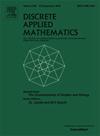A note on obtaining bipartite radio graceful graphs of arbitrarily large radio numbers with radio graceful complements
IF 1
3区 数学
Q3 MATHEMATICS, APPLIED
引用次数: 0
Abstract
Motivated by the frequency assignment problem (FAP), a radio coloring of a graph is an assignment of non-negative integers to the vertices of satisfying the condition , where is the distance between any two vertices and of the graph . The span of a radio coloring of is the difference of the maximum and minimum non-negative integers used as colors. The minimum span of a radio coloring of is referred as the radio number of . Any radio coloring with the minimum span is referred as an optimal radio coloring of . If an optimal radio coloring of is a bijection from to , then the graph is referred as radio graceful. In this article, using a recursive construction, we have shown that for each positive integer , there exists a bipartite graph with vertices such that both and its complement are radio graceful graphs. In the process, we show that each such and contain a Hamiltonian path.
Note that our construction obtains radio graceful graphs of arbitrarily large radio numbers without going for big cliques. This has an interesting similarity with the motivation behind the Mycielski’s construction which ensures the existence of an infinite family of triangle- free graphs with arbitrarily large chromatic numbers. However, the growth of the vertex size in our recursive construction is linear unlike the Mycielski’s construction which yields exponential growth of the vertex size.
关于获得具有任意大无线电数的无线电优美补的二部无线电优美图的注记
在频率分配问题(FAP)的激励下,图G的无线电着色是将非负整数f赋值给满足条件|f(u)−f(v)|+d(u,v)≥G+1的直径的G的顶点,其中d(u,v)是图G的任意两个顶点u和v之间的距离。G的无线电着色的空间是用作颜色的最大和最小非负整数之差。G的一个无线电染色的最小张成空间称为G的无线电数。任何具有最小张成空间的无线电染色称为G的最优无线电染色。如果G=(V,E)的最优无线电染色是V到{0,1,…,|V|−1}的双射,则该图称为无线电优美。本文利用递归构造,证明了对于每一个正整数n≥9,存在一个有n+1个顶点的二部图Gn,使得Gn及其补Gnc都是无线电优美图。在这个过程中,我们证明了每一个这样的Gn和Gnc都包含一个哈密顿路径。注意,我们的构造得到任意大的无线电数的无线电优美图,而不需要大的集团。这与Mycielski构造背后的动机有一个有趣的相似之处,Mycielski构造保证了具有任意大色数的无限族无三角形图的存在性。然而,在我们的递归结构中,顶点大小的增长是线性的,而不像Mycielski的结构那样产生顶点大小的指数增长。
本文章由计算机程序翻译,如有差异,请以英文原文为准。
求助全文
约1分钟内获得全文
求助全文
来源期刊

Discrete Applied Mathematics
数学-应用数学
CiteScore
2.30
自引率
9.10%
发文量
422
审稿时长
4.5 months
期刊介绍:
The aim of Discrete Applied Mathematics is to bring together research papers in different areas of algorithmic and applicable discrete mathematics as well as applications of combinatorial mathematics to informatics and various areas of science and technology. Contributions presented to the journal can be research papers, short notes, surveys, and possibly research problems. The "Communications" section will be devoted to the fastest possible publication of recent research results that are checked and recommended for publication by a member of the Editorial Board. The journal will also publish a limited number of book announcements as well as proceedings of conferences. These proceedings will be fully refereed and adhere to the normal standards of the journal.
Potential authors are advised to view the journal and the open calls-for-papers of special issues before submitting their manuscripts. Only high-quality, original work that is within the scope of the journal or the targeted special issue will be considered.
 求助内容:
求助内容: 应助结果提醒方式:
应助结果提醒方式:


